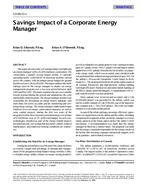Click here to purchase
Ideally moisture analysis of buildings is based on statistical analysis where the probability of failure, loads and design parametersare stochastic variables, similar to limit state design for structural engineering. However, many industry professionals andstandards, such as ASHRAE Standard 160, acknowledge that sufficient information is rarely available to make a full statisticalanalysis practical. Informed design decisions must balance the best available information as well as professional judgment. Evenso, informed decisions require assumptions that will closely parallel reality, and not be too stringent or optimistic, so that durability,energy efficiency, occupant comfort, and architectural requirements are not unnecessarily sacrificed. This paper presentsa case study of systematically evaluating the feasibility of insulating existing uninsulated painted brick masonry walls. Specifically,how to manage uncertainty through computer simulations that incorporate findings from the investigation of study buildings. Criticalassessments of the risks are combined with an analysis of the benefits to energy consumption and interior thermal comfort.This project included field investigations, lab testing of brick samples for hygrothermal properties and freeze-thaw damage criteria,and computer simulations. Simulations included 1-D/2-D hygrothermal, 3-D thermal, and whole-building energy analysis.The analysis and investigation informed possible retrofit options that were presented using data visualization techniques so a clearpicture of the potential energy savings and improvements to thermal comfort could be effectively presented to the design team.Uncertainty can never be eliminated and information is not readily available to apply safety factors based on statistical probabilities,notwithstanding all of the effort to ensure that the assumptions were appropriate for the specific project conditions.Design decisions are made based on well-informed findings, sensitivity analysis, and engineering judgment. The presence ofpainted brick surfaces presented additional challenges from an analysis stand-point but also provided opportunities to correlateobserved freeze-thaw damage to simulated damage. Ultimately, uncertainty was managed by systematically evaluating how criticalassumptions affected the findings and related these findings to the architectural and owners’ vision. The objective of this paperis to highlight how to manage uncertainty in practice when computer simulations are guiding design, so that moisture concernscan be addressed while balancing energy efficiency and thermal comfort objectives.
Citation: Thermal Performance of Exterior Envelopes of Whole Buildings XIII, Conference Papers
Product Details
- Published:
- 2016
- Number of Pages:
- 13
- Units of Measure:
- Dual
- File Size:
- 1 file , 3.1 MB
- Product Code(s):
- D-BldgConf16-67


